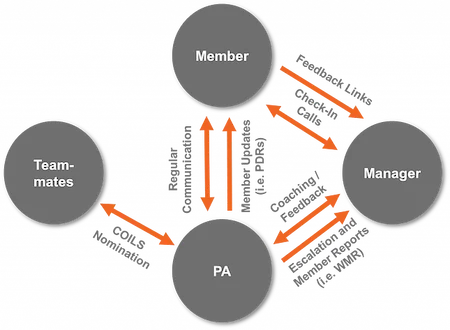
- admin
- August 14, 2013
- 8:57 am
Managing Happiness: 5 Feedback Tips for a Global Workplace
This is the second article in Quickskill’s Managing Happiness in a Global Workplace series, in which we aim to describe how and why to manage employees so that they are happy, motivated and engaged from a distance. Other topics include meaning vs. money in a job, gamification with overseas employees and the philosophy of happiness at work in a global context.
Gathering feedback, according to Gallup, “has spread like kudzu across the corporate landscape.” Companies ask for feedback at conferences and team offsites, in advertisements, on investor calls and, perhaps most often, at client meetings and site visits. With the consulting world at the lead, collecting and (over-)analyzing survey data has become an everyday occurrence for most employees. Whether they are actually helpful depends more on the manager’s response to feedback rather than the feedback instrument itself.
Yet, psychologists and management profs alike have long touted feedback as being a key way to increase a company’s bottom line. Feedback gives employees an opportunity to express their frustrations and needs, which in turn makes them aware of their own voices. If the company is responsive to employee feedback, that will boost worker engagement, which in turn leads to higher profits.
Feedback at a Global Scale
In the global context, feedback can be a daunting concept to both explain and execute across cultural lines. Among the many workplace differences between Tokyo and Toronto or between Delhi and Denver, the expectation and meaning of “respect” tends to be the greatest. Whether or under what circumstances an employee can speak up and criticize the system or his team lead is deeply ingrained in corporate culture. In the Philippines, for example, workers are known for smiling and agreeing with the boss, even if they haven’t understood the task. As a result, the worker is more likely to receive negative feedback, despite his can-do attitude.
If it’s done right, though, the biggest benefit of feedback is to hit at the “sense of purpose” that Daniel Pink identified as being essential to the happiness at work quotient. Employees want to identify with a company’s goals and values to make their own work seem meaningful. In this context, it’s not just the employee’s own feedback that matters. Quite often, soliciting active feedback from customers and sharing that with workers can contribute to this sense of self.
Building an Effective Feedback Loop
Quickskill has developed a feedback loop that incorporates each of these elements. The goal is to both improve employee engagement and our customers’ experience. And while it’s not a typical 360-degree evaluation, the most prominent attribute of this loop is to involve various different parties in the feedback. Team leaders provide feedback both up and down the chain. Individual assistants get daily feedback from members and often from overseas managers as well.
Quickskill’s Top 5 Feedback Strategies
Within the loop framework, we’ve developed distinct ways of both soliciting and reacting to feedback with our cross-border staff. Here are our 5 favorites:
- Make it real-time: We aim to give feedback to new team members on a weekly basis. Those who are struggling get it a bit more often, while the general workforce is evaluated at least every 6 weeks. We track these evaluations (and each of our team members) in Salesforce, so that we never miss an opportunity to discuss someone’s work with them in a timely manner. Being consistent and up-to-date when giving feedback is key. Employees will feel empowered, and will know that their bosses are interested in their personal professional development. This has helped us take otherwise mediocre workers and turn them into star employees, and even team leaders.
- Get them while they’re fresh: Our CEO directly solicits feedback from each team member after their first 4 weeks on the job. At this point, employees have a basic understanding of the role and the company, but still have fresh eyes and ideas. Quite often, their ideas are things that they can, and are encouraged to, implement themselves. We’ve often solicited newbie’s advice directly on training exercises to supplement our onboarding materials and employee handbook.
- Public feedback: Quickskill has an internal listserv where our team captains can send out positive feedback from our customers. Usually, assistants are individually singled out in these emails for thanks or congratulations by the members that they work with. Everybody from the COO on down receives and responds to these emails publicly, so that the assistant is recognized for the great work that he is doing. The accomplishment is also inspiring for his colleagues to see and sometimes lead to new member processes, such as changes in how we answer our phone calls or send scheduling emails.
- Focus on the soft stuff: We believe the devil is in the details when it comes to employee engagement. That’s why we implement Gallup’s Q12 feedback method with our assistants. The survey focuses on 12 team-level questions that go to the heart of an employee’s everyday life at the company – a life that we usually won’t see, sitting in an office thousands of miles away. Do they have a best friend at work? Do they have the materials they need to get the job done? These things are the same – and equally important – regardless of the culture, geography or seniority of the employee.
- Involving the customer: Quickskill asks its members to give us daily feedback on the tasks we complete for them. We do this by embedding a simple number score in our end-of-day wrap-up email to the member. We tell them what we’ve worked on for them that day, and then ask them for a simple click on the score. Getting customers to voluntarily provide this feedback is not an easy feat, especially when we’re asking busy American CEOs to interact daily with their Filipino assistant. But we’ve made it a priority to earnestly solicit this score for our employees’ sakes. Each assistant has immediate access to his/her member’s daily score. This not only inspires them, but gives them a sense of mastery and meaning that’s essential to their happiness at work.
Bonus Tip: The majority of our feedback is collected using electronic forms, which then put the data directly into the individual’s Salesforce record. This not only makes it easy to gather and analyze feedback, but it also gives a supervisor all the information he needs in one spot to address feedback for a particular employee.
We believe that giving and receiving feedback across a global workforce is not just possible, but essential. Our team is energized and motivated by knowing that they’ll be heard, even if we’ve never physically met. And keeping them engaged means they will keep our customers engaged. Ultimately, we think that is good business.
Coming soon: Why gamification is a necessary, though not necessarily expensive, ingredient for happiness in the workplace.
Amplify Your Productivity
With 2022’s Virtual Assistant Service
Read More
Categorized
Posts you might also like...

6 Leadership Quotes on Delegation to Inspire You to Greatness
February 5, 2023

How a Delegative Leadership Style Improves Team Success
February 5, 2023

How to Use MOCHA to Delegate Effectively
February 5, 2023


